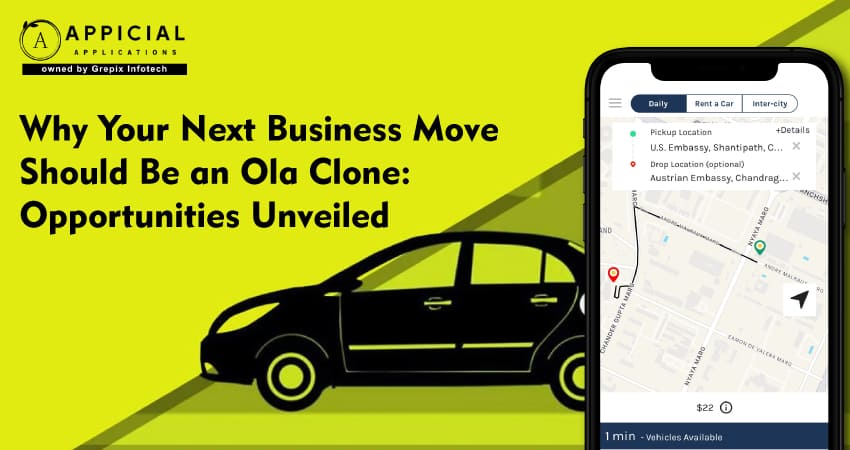
Why Your Next Business Move Should Be an Ola Clone
In the bustling market of ride-hailing services, replicating a successful model like Ola's offers a lucrative pathway for entrepreneurs and businesses aiming to penetrate or expand within this space.
Welcome to the fast-evolving world of mobility and transportation! As a forward-thinking taxi app development company, we're here to explore an exciting opportunity that could redefine the way you think about entering the ride-hailing market. The focus of today's discussion is on why creating an Ola clone could be your next big business move.In recent years, companies like Ola have transformed urban mobility, making it more convenient, reliable, and accessible. Their success stories offer a blueprint for potential growth and profitability in the ride-sharing industry. This blog will unveil the manifold opportunities that an Ola clone presents, from tapping into a ready market to leveraging established operational models that work.
Join us as we dive deep into the benefits of following in the footsteps of giants, and how doing so could not only fast-track your entry into the market but also scale your business rapidly. Whether you are looking to start fresh or expand your current offerings, understanding the strategic advantages of an Ola clone could be the game-changer you need. Let's discover how this smart move can set you on the path to success in the competitive world of ride-hailing.
This blog from a taxi app development company's perspective delves into why creating an Ola clone is a strategic move and outlines the untapped opportunities it presents.
This blog explores the advantages of launching an Ola clone as a strategic move in the competitive ride-hailing market. Highlighting Ola's successful business model, it outlines how new entrepreneurs can capitalize on expanding market dynamics and technological advancements. The discussion includes key steps like market research, compliance with regulatory requirements, technological development, and pilot testing. It emphasizes the importance of innovative revenue streams, community impact, and sustainable practices. By adopting Ola’s proven strategies, new entrants can quickly gain market share, support local economies, and foster customer loyalty, positioning themselves for success in transforming urban mobility.
Expanding Market Reach
- Rapid Growth in Ride-Hailing: The global ride-hailing service market is on an impressive growth trajectory, driven by several key factors. Increasing urbanization and the proliferation of smartphone technology have made these services more accessible than ever. Furthermore, there is a noticeable shift in consumer behavior, particularly among millennials and Gen Z, who prefer access over ownership when it comes to transportation. By adopting an Ola clone, entrepreneurs can utilize a tried and tested business model to capitalize on these expanding market dynamics, ensuring a robust entry and sustained growth in the ride-hailing sector.
- Diverse Geographic Appeal: Ola's success is partly due to its ability to adapt locally—tailoring its services to meet the specific needs of various regions. This local adaptability can be a significant advantage for new businesses using an Ola clone to enter diverse markets. Customizing services to align with regional preferences in vehicle types, payment methods, and language options can greatly enhance user experience and overall customer satisfaction, paving the way for a more personalized and successful service offering.
Leveraging Established Business Models
- Proven Strategies: The strategies employed by Ola—ranging from competitive pricing and strong driver partnerships to innovative customer engagement tactics—are not just effective, but also well-tested across multiple markets. New businesses leveraging an Ola clone can adopt these mature strategies to sidestep common entrepreneurial pitfalls, allowing them to focus more on scaling up and refining their business processes.
- Innovative Revenue Models: Ola has effectively diversified its income streams beyond mere ride fares. This includes subscriptions, car rentals, and even branching into food delivery in certain markets. Such a multifaceted approach to revenue can be replicated by an Ola clone, providing multiple streams of income from a broad customer base and enhancing overall business resilience.
Technological Edge
- Advanced Tech Integration: Ola incorporates state-of-the-art technology in its operations, utilizing artificial intelligence for demand forecasting and real-time decision-making. Cloning such technological capabilities can lead to significant reductions in operational costs and enhance service reliability, giving new entrants a strong competitive edge.
- Customizable Platforms: While a clone implies replication, it doesn't mean a lack of innovation. Cloning Ola provides the groundwork upon which further innovations can be built. This could involve integrating local transportation options, introducing hybrid vehicle choices, or adding advanced safety features. Such enhancements not only differentiate your service in a competitive market but also cater to evolving consumer demands.
Also Read: How to Start Your Taxi Business with inDriver Clone
Community and Environmental Impact
- Sustainability Initiatives: In an era where environmental impact is a growing concern, launching a ride-hailing service that includes electric vehicles and promotes carpooling options—similar to Ola—can attract environmentally conscious consumers and contribute to global sustainability efforts.
- Supporting Local Economies: Ride-hailing services like Ola have a significant positive impact on local economies by providing flexible job opportunities and improving overall mobility. An Ola clone can be customized to maximize these economic benefits, supporting not just consumers but also local drivers and businesses, fostering a robust local ecosystem.
Marketing and Customer Retention
- Brand Development: Launching with an Ola clone can facilitate rapid brand recognition and development. This strategy leverages the success of an existing brand, allowing new entrants to deploy marketing strategies that are both bold and effective, accelerating market penetration and brand loyalty.
- Enhanced Customer Experience: Ola’s focus on building customer loyalty through comprehensive rewards programs, high-quality service, and responsive customer support is a blueprint that can be effectively replicated. Emulating these strategies can help cultivate a loyal customer base for the clone platform, ensuring long-term success and stability in the marketplace.
Steps to Launch Your Ola Clone
Launching an Ola clone involves several strategic steps to ensure that the platform is well-positioned to compete in the crowded ride-hailing market. Here’s a comprehensive guide to get you started:
1. Market Research and Analysis
- Identify Target Markets: Understand where your service will be most in demand. Look into different cities or countries, their transport needs, regulations, and competitor presence.
- Analyze Competitor Strategies: Study how established players like Ola operate and how they price their services, their marketing tactics, and customer loyalty programs.
- Understand Consumer Behavior: Gather insights about potential users’ preferences, which type of vehicles they prefer, their payment methods, and what features they value the most.
2. Obtain Necessary Licenses and Permits
- Regulatory Compliance: Different regions have different requirements for ride-hailing services. Ensure that you have all necessary permissions and licenses to operate legally in your chosen markets.
3. Technology Development
- App Development: Develop a user-friendly app interface for both drivers and passengers. Make sure the app includes features like real-time tracking, ride booking, payment integration, driver and vehicle details, and customer support.
- Backend Infrastructure: Build a robust backend to handle bookings, dispatch, customer queries, and data analytics effectively.
- Adopt Cutting-edge Technologies: Integrate advanced technologies such as AI for demand forecasting, GPS for location tracking, and perhaps blockchain for secure transactions.
4. Vehicle and Driver Onboarding
- Partnership with Vehicle Owners: Formulate partnerships with vehicle owners who can register their vehicles on your platform. Ensure these vehicles meet the safety and comfort standards of your service.
- Driver Recruitment and Training: Recruit drivers and provide them with necessary training to meet service quality standards. Implement background checks and vehicle inspections as part of the onboarding process.
5. Define Pricing and Revenue Model
- Competitive Pricing Strategy: Set pricing that is competitive yet sustainable. Consider dynamic pricing models based on demand and supply.
- Diversified Revenue Streams: Explore various revenue models such as ride fares, subscription services, in-app advertising, and ancillary services like food and parcel delivery.
6. Launch a Pilot Program
- Start Small: Begin with a pilot program in a selected area to iron out any operational kinks and gauge user response.
- Gather Feedback: Use the pilot as an opportunity to collect user feedback and make necessary adjustments to your service and app functionalities.
7. Marketing and Brand Building
- Brand Identity: Create a strong brand identity that resonates with your target audience. This includes a compelling logo, app design, and an overall aesthetic that reflects your brand values.
- Marketing Campaigns: Deploy targeted marketing strategies such as social media advertising, partnerships with local businesses, promotional offers, and community events to build awareness and attract users.
8. Continual Improvement and Innovation
- Upgrade Technology: Continuously improve your app and service based on technological advancements and customer feedback.
- Sustainability Initiatives: Implement and promote sustainability initiatives like electric vehicles and carpooling options to appeal to eco-conscious consumers.
Conclusion
Venturing into the ride-hailing market with an Ola clone presents a unique and lucrative opportunity for aspiring entrepreneurs and established businesses alike. By leveraging a proven business model, integrating advanced technologies, and adapting to local market demands, you can quickly establish a foothold in this competitive industry.
The success of Ola underscores the vast potential in the ride-hailing space—highlighting not just the financial gains but also the opportunity to make a positive impact on local communities and the environment. An Ola clone allows you to capitalize on these benefits with significantly reduced risk and accelerated time to market.
As you consider your next business move, think about the diverse possibilities an Ola clone offers. From expanding market reach and adopting innovative revenue models to enhancing customer satisfaction and promoting sustainability, the benefits are clear. With the right strategy and execution, your ride-hailing service can drive past the competition and lead the way in transforming urban mobility.
Embark on this journey with confidence, knowing that you are not just starting a business but also contributing to a smarter, more sustainable future in transportation. Whether you are aiming to disrupt existing markets or introduce new efficiencies to underserved regions, an Ola clone could indeed be the game-changer your business needs.





